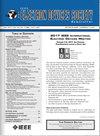Enhancement of the Transient Current Behavior of MIS Tunnel Diodes With Ultra-Edge-Thickened (UET) Oxide under the Consideration of Tunnel Oxide Areas
IF 2.4
3区 工程技术
Q3 ENGINEERING, ELECTRICAL & ELECTRONIC
引用次数: 0
Abstract
In this research, the steady-state and transient behavior of the p-type metal-insulator-semiconductor (MIS) tunnel-diodes (TD) with ultra-edge-thickened (UET) oxide was studied, utilizing experimental results and TCAD simulations. The investigation explores how the gate voltage (VG) influences the gate current (IG). Additionally, the impact of the thin oxide area under the gate (Athin) on IG is examined. When VG < VFB, which is in forward bias, IG is directly proportional to Athin, resulting in a larger |IG| for the planar devices with only thin oxide. Conversely, for V考虑隧道氧化区的情况下,超边缘增厚(UET)氧化物增强MIS隧道二极管瞬态电流行为
在本研究中,利用实验结果和TCAD模拟,研究了具有超边缘增厚(UET)氧化物的p型金属-绝缘体-半导体(MIS)隧道二极管的稳态和瞬态行为。研究栅极电压(VG)对栅极电流(IG)的影响。此外,还研究了栅下的薄氧化区(thin)对IG的影响。当VG < VFB处于正偏置时,IG与thin1成正比,使得仅含薄氧化物的平面器件的|更大。相反,在V ${}_{\text {G}} \gt $ 0 V下,由于栅极外区域提供了更多的电子,UET器件表现出比平面器件更高的IG。与平面器件相比,UET器件的瞬态电流增强了100多倍。此外,具有较大厚度的UET器件显示更大的瞬态电流。然而,当薄氧化层和厚氧化层的面积几乎相等时,瞬态电流的增强趋于饱和。在将VG从写入切换到0 V后,在60 ms时对UET器件的瞬态电流的大小进行采样。还测量了耐久性特性,揭示了1000个写入和读取周期后的最小变化。为了阐明稳态和暂态电流行为背后的机制,对稳态和暂态情况进行了模拟。
本文章由计算机程序翻译,如有差异,请以英文原文为准。
求助全文
约1分钟内获得全文
求助全文
来源期刊

IEEE Journal of the Electron Devices Society
Biochemistry, Genetics and Molecular Biology-Biotechnology
CiteScore
5.20
自引率
4.30%
发文量
124
审稿时长
9 weeks
期刊介绍:
The IEEE Journal of the Electron Devices Society (J-EDS) is an open-access, fully electronic scientific journal publishing papers ranging from fundamental to applied research that are scientifically rigorous and relevant to electron devices. The J-EDS publishes original and significant contributions relating to the theory, modelling, design, performance, and reliability of electron and ion integrated circuit devices and interconnects, involving insulators, metals, organic materials, micro-plasmas, semiconductors, quantum-effect structures, vacuum devices, and emerging materials with applications in bioelectronics, biomedical electronics, computation, communications, displays, microelectromechanics, imaging, micro-actuators, nanodevices, optoelectronics, photovoltaics, power IC''s, and micro-sensors. Tutorial and review papers on these subjects are, also, published. And, occasionally special issues with a collection of papers on particular areas in more depth and breadth are, also, published. J-EDS publishes all papers that are judged to be technically valid and original.
 求助内容:
求助内容: 应助结果提醒方式:
应助结果提醒方式:


